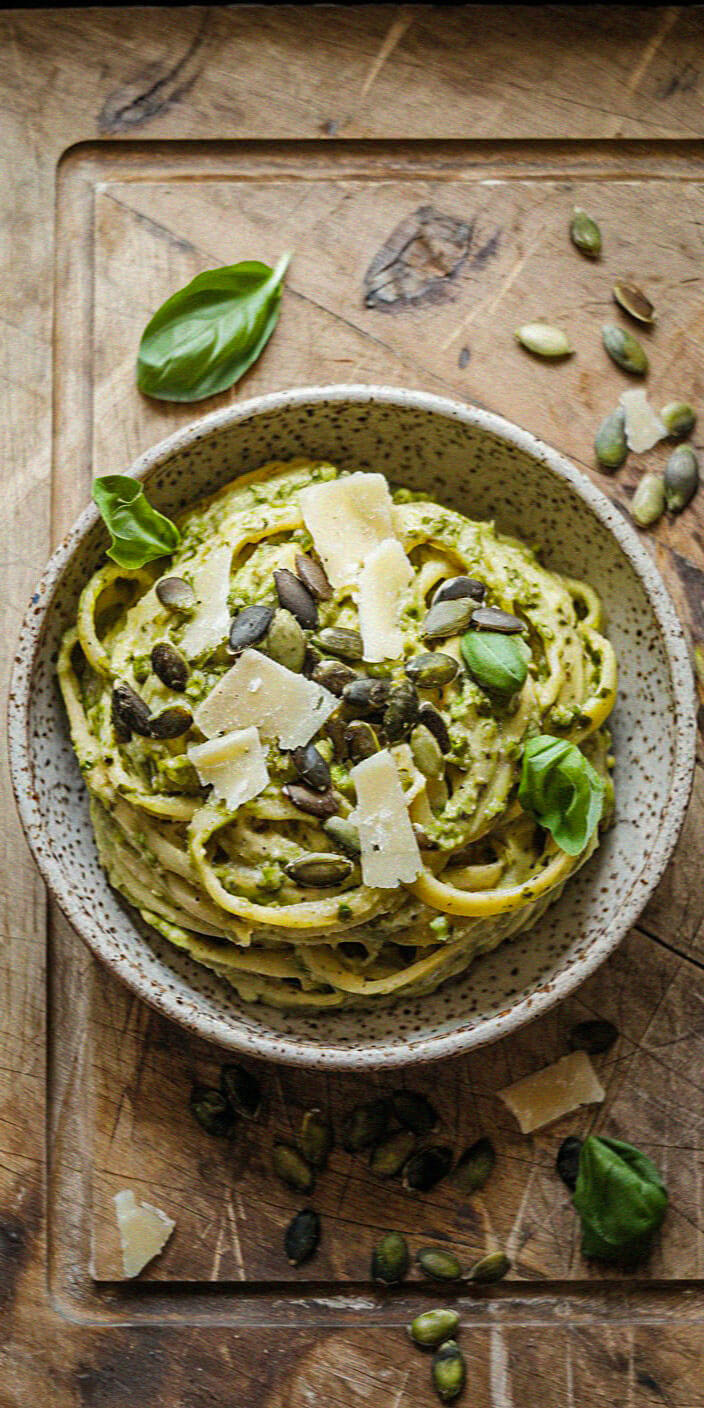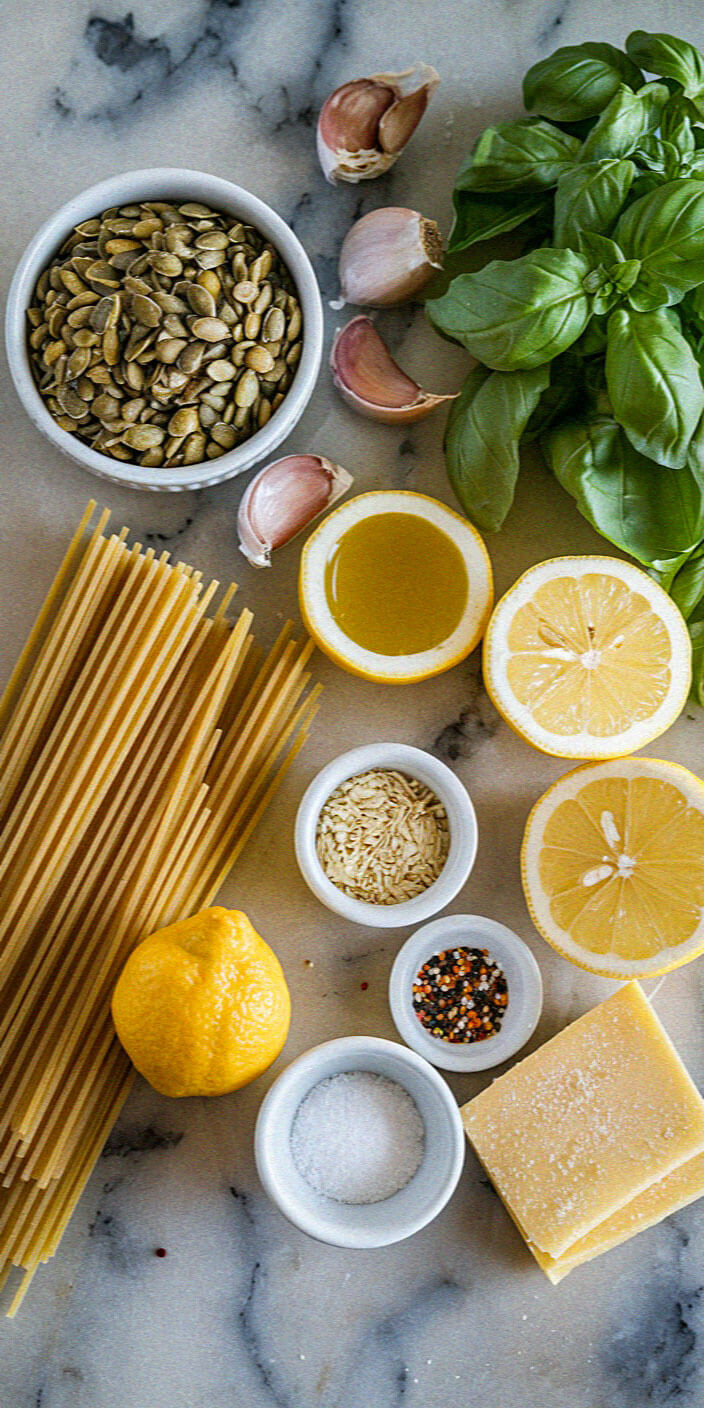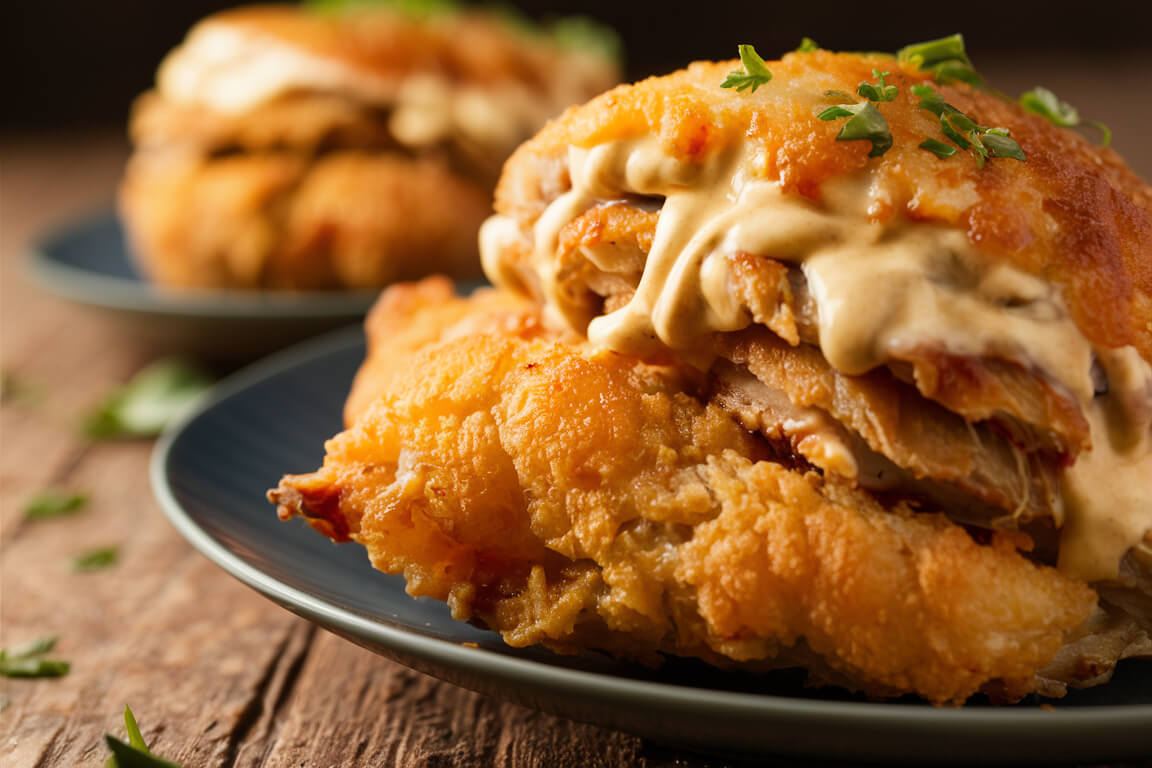
This website contains affiliate links. As an Amazon affiliate, I earn from qualifying purchases (What’s This?).
If you’ve ever stood in your kitchen with a bundle of fresh herbs and wondered how to turn them into something special, this recipe is your sign.
Pumpkin seed pesto pasta takes the comfort of your favorite basil pesto and gives it a toasty, nutty, slightly garlicky edge that feels fresh, seasonal, and deeply satisfying.

Whether you’re looking for a vegan, nut-free option or just a way to use up leftover pumpkin seeds, this is the kind of recipe that’s both flavorful and simple enough to make on a weekday.
What Ingredients Are In This Pasta Recipe
(Serves 4)

For the Pumpkin Seed Pesto
- 1 cup pumpkin seeds (pepitas), raw or lightly roasted
- 2 cloves garlic (use roasted garlic for a milder, sweeter flavor)
- 2 cups fresh basil leaves (or a mix of basil and spinach for a softer flavor)
- ½ cup extra virgin olive oil, plus more for drizzling
- 2 tablespoons lemon juice
- 2 tablespoons nutritional yeast or ¼ cup freshly grated parmesan cheese
- Salt and pepper to taste
- ¼ teaspoon chilli flakes (optional, for a little kick)
For the Pasta
- 12 ounces spaghetti or short pasta (penne, fusilli, or your favorite gluten-free pasta)
- ½ cup reserved pasta water
- Olive oil for drizzling
- Additional toasted pumpkin seeds, for garnish
- Freshly grated parmesan or nutritional yeast, for serving
- Lemon zest, for finishing touch
Instructions
Step 1: Toast the Pumpkin Seeds
Start by toasting your pumpkin seeds to bring out their natural nuttiness. Place them in a dry skillet over medium heat and toast for about 3–4 minutes, stirring often, until they start to pop and turn golden brown.
Keep an eye on them, pumpkin seeds can go from toasted to burnt in a flash.
Once toasted, set aside a small handful for garnish later.
Step 2: Blend the Pesto
In a food processor, combine the remaining toasted pumpkin seeds, garlic, basil, lemon juice, nutritional yeast (or parmesan), and a good pinch of salt and pepper. Pulse a few times to chop everything down.
With the food processor running, slowly drizzle in the olive oil until you reach a thick, creamy consistency.
You may need to stop and scrape down the sides once or twice. Taste and adjust, add more lemon juice for brightness, salt for balance, or a touch more olive oil if you prefer a silkier texture.
If you like your pesto chunky, pulse it fewer times. For a smoother version, process until smooth and creamy.
Step 3: Cook the Pasta
Bring a large pot of salted water to a boil and cook your pasta according to package directions. Reserve about half a cup of pasta water before draining.
Step 4: Toss Everything Together
Return the drained pasta to the pot, then add 4–5 generous tablespoons of your freshly made pesto. Add a splash of pasta water and toss everything together over low heat until the sauce coats every strand beautifully.
The starchy water helps create a creamy pesto sauce that clings to the pasta like a dream.
Step 5: Serve and Garnish
Plate your pasta, then drizzle with a little extra virgin olive oil for shine and richness.
Sprinkle over the reserved toasted pumpkin seeds, a pinch of chilli flakes, and some freshly grated parmesan or nutritional yeast. Finish with a whisper of lemon zest for that final, bright lift.
Serve immediately while it’s warm, or enjoy it cold as a refreshing pesto pasta salad the next day, it’s just as good.
Optional Add-Ins
- Spinach or kale: Add a handful to the pesto for extra greens and subtle flavor.
- Chilli flakes: For a garlicky kick that pairs beautifully with roasted seeds.
- Roasted veggies: Zucchini, cherry tomatoes, or bell peppers make the dish heartier.
- Pistachio or walnut blend: For a different take on the classic pumpkin seed pesto.
Storage Tips
Store any leftover pesto in an airtight jar in the fridge for up to 5 days. Drizzle a thin layer of olive oil on top to keep it from oxidizing. You can also freeze it in ice cube trays for quick, single-use portions, perfect for last-minute dinners.
If it thickens in the fridge, just stir in a splash of olive oil or lemon juice before serving.
Recipe Notes
- This version is completely nut-free and can be made gluten-free by using your favorite alternative pasta.
- For a vegan twist, skip the parmesan and use nutritional yeast instead, it gives that same cheesy, umami richness.
- Wild garlic or roasted garlic both add a wonderful depth of flavor.
- Leftover pesto isn’t just for pasta, try spreading it on toast, tossing it with roasted potatoes, or drizzling over grilled veggies.
What Makes Pumpkin Seed Pesto Pasta So Special?

Pesto has long been the darling of easy, elegant cooking, bright green, full of life, and endlessly versatile.
But swapping traditional pine nuts for pumpkin seeds brings an earthy richness that makes this pesto sauce stand out.
The flavor deepens beautifully when you roast the seeds first, giving the final dish a subtle crunch and warm undertone that pairs perfectly with pasta.
There’s also something undeniably comforting about using pantry ingredients to create something luxurious.
This pesto recipe uses just a handful of pesto ingredients, garlic, basil, olive oil, and lemon juice, but with pumpkin seeds at the center, the result feels both rustic and elevated.
Why Use Pumpkin Seeds Instead of Pine Nuts?
Traditional basil pesto relies on pine nuts, but they can be expensive and sometimes hard to find.
Pumpkin seeds, on the other hand, are affordable, rich in healthy fats, and have a naturally toasty, nutty flavor.
When you roast them lightly before blending, they take on a flavor that’s both buttery and earthy, somewhere between pistachio and walnut.
Using pumpkin seeds also makes this version nut-free, which means it’s safe for anyone with allergies.
It’s a small swap that changes everything. Plus, pumpkin seeds give a lovely green hue to the pesto and a satisfying texture when blended.
How to Make the Perfect Pumpkin Seed Pesto
Making pesto from scratch is much easier than it looks. The key is balance: the freshness of basil, the garlicky flavor of raw or roasted garlic, the acidity from lemon juice, and the richness from olive oil.
Start by toasting your pumpkin seeds in a dry pan until they’re just golden, about three minutes should do it. This simple step enhances their natural nuttiness and adds depth to your pesto sauce.
Then, add them to a food processor with fresh basil leaves, garlic cloves, and a generous drizzle of extra virgin olive oil. Blend until everything starts to come together.
Add salt and pepper to taste, a squeeze of lemon juice for brightness, and if you’d like a richer flavor, toss in some nutritional yeast or freshly grated parmesan.
Process until smooth, scraping down the sides if needed. You can make the pesto as chunky or as creamy as you prefer.
How Does Wild Garlic Pesto Change the Flavor?
Wild garlic pesto is the springtime cousin of classic basil pesto. If you’re lucky enough to forage wild garlic, it brings a milder, more rounded garlic taste that’s less sharp than raw cloves.
The leaves blend beautifully with pumpkin seeds, creating a sauce that feels green, fragrant, and slightly wild.
If you can’t find wild garlic, you can substitute it with spinach or kale for a mild, fresh twist. The beauty of pesto is its flexibility, every version tells its own story.
What’s the Best Pasta for Pumpkin Seed Pesto?
Pesto pairs beautifully with almost any pasta shape, but some choices let the sauce cling better than others.
Spaghetti gives a light, elegant result, while short shapes like penne or fusilli hold more pesto in every bite. If you’re avoiding gluten, this pesto pasta works perfectly with gluten-free options made from rice, chickpeas, or lentils.
The most important part? Toss your cooked pasta with a bit of reserved cooking water. This starchy liquid helps the pesto coat every strand or twist, turning it into a silky, restaurant-quality pasta dish that feels effortless.
Can This Pesto Be Vegan?
Yes, and it’s naturally so when you skip the parmesan. Pumpkin seeds are rich enough on their own that you won’t miss the cheese.
To mimic that savory, umami depth, try adding a spoonful of nutritional yeast, it brings the same richness you’d get from parmesan cheese.
This version is nut-free, vegan, and gluten-free depending on the pasta you choose. It’s a great recipe for dinner parties where you want to please everyone without juggling dietary restrictions.
How to Roast and Toast Pumpkin Seeds for Maximum Flavor
To roast pumpkin seeds for pesto, spread them evenly on a baking sheet and toast in the oven at 350°F (175°C) for about five to seven minutes. You’ll know they’re ready when they smell nutty and start to pop.
If you prefer to toast them on the stovetop, use a dry skillet over medium heat and stir frequently to avoid burning. The goal is to coax out their natural oils without over-roasting. Once cooled, they’re ready to blend.
This roasting step makes a noticeable difference, it transforms plain seeds into a toasty base that gives your pesto a beautifully deep, savory character.
How to Make the Pasta Sauce Creamy and Flavorful
Once you’ve blended your pesto, the magic happens when it meets the pasta. After draining your pasta, return it to the pot with a drizzle of olive oil and a few spoonfuls of pesto. Toss well to coat, adding small splashes of pasta water as needed to create a creamy consistency.
If you want an extra boost of freshness, stir in some lemon zest or a sprinkle of chilli flakes for gentle heat. For a cozy dinner, top with roasted veggies or a handful of spinach for a green-on-green finish.
This pumpkin pesto pasta recipe turns humble ingredients into something gourmet, each bite creamy, garlicky, and deeply flavorful.
What Can You Add for Texture and Garnish?
A sprinkle of toasted seeds or grated parmesan cheese adds a beautiful contrast in texture. If you’re keeping things vegan, crushed hazelnut or a touch of nutritional yeast works beautifully too.
You can even garnish with roasted kale chips or a drizzle of extra virgin olive oil for that restaurant finish.
For a more colorful twist, add roasted veggies, think zucchini, bell peppers, or cherry tomatoes. They bring brightness and balance to the pesto’s richness.
How Long Does Pumpkin Seed Pesto Last in the Fridge?
If you store any leftover pesto in an airtight jar, it’ll keep in the fridge for up to a week.
Drizzle a thin layer of olive oil over the top to seal in freshness. You can also freeze it in small portions, perfect for quick weeknight dinners.
To revive it, simply stir in a little olive oil or lemon juice before serving. The flavor holds beautifully, and in some cases, it even deepens with time.
What Makes This Pesto Recipe So Easy to Make?
Part of what makes this such a great recipe is that it’s easy to make, yet feels like something you’d find in a chic little trattoria. All you need is a food processor, a few fresh herbs, and a willingness to taste as you go.
The pesto ingredients, pumpkin seeds, garlic, basil, olive oil, and lemon juice, come together in minutes. Blend, toss, garnish, and serve.
You don’t need to be a chef to master this. You just need a love for good, honest food that celebrates simplicity.
My Favorite Ways to Serve Pumpkin Seed Pesto Pasta
This pesto pasta isn’t just for dinner. It’s fantastic served chilled as a pasta salad, spooned over grilled veggies, or spread on warm toasted bread.
You can even use it as a base for pizza instead of tomato sauce, or drizzle it over roasted potatoes for an easy upgrade.
If you’re meal prepping, store any leftover pesto in a jar in the fridge. It’s one of those recipes that makes every meal feel a little more special, flavorful, vibrant, and impossibly fresh.
This website contains affiliate links. As an Amazon affiliate, I earn from qualifying purchases (What’s This?).





